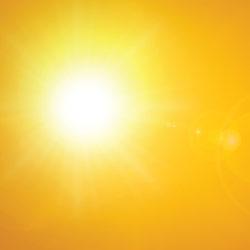
In one of their findings, Vision Council’s 2015 UV Protection Report indicated that nearly 7 in 10 American adults surveyed were unaware of the link between sun exposure and serious vision problems.
The Barnet Dulaney Perkins Eye Center aims to take an active role in filling in these knowledge gaps on the risks and dangers of sun damage to eyes.
In this blog post, you will learn the following:
- How ultraviolet (UV) radiation impacts the eyes
- Factors that increase your risk of eye damage from UV radiation
- UV-related eye problems and issues
- The single most important thing you can do to protect your eyes from too much UV exposure
What Does the Sunlight Do to Your Eyesight
In a nutshell, the sun emits 3 types of UV radiation: UVA, UVB, and UVC. All three are invisible to the human eye,
but it’s incredibly important to protect your skin and eyes from their damaging effects.
- UVC radiation is the most dangerous of the three. Fortunately, UVC rays are mostly absorbed by the earth’s ozone layer before it reaches the earth’s surface.
- On the other hand, UVB’s longer wavelength allows it to bypass the ozone layer. This type of UV radiation is responsible for your skin tan after spending hours under the sun. Overexposure to UVB has been linked to pterygium (surfer’s eye) and also associated with photokeratitis (snow blindness).
- UVA radiation can pass through the cornea and eventually reach the lens and retina. As a result, overexposure to UVA can potentially result in cataract and may play a role in the development of macular degeneration.
Meanwhile, the cumulative effects of high-energy visible (HEV) radiation (also known as blue light) or the visible part of UV radiation has been shown to damage the retina. As a result, it has been strongly identified as a contributing factor to age-related macular degeneration.
It is worth noting that moderate sunlight exposure can positively impact eye health too. Sunlight has been shown to help reduce insomnia by regulating the sleep-wake cycle. Research by The Ohio State University College of Optometry revealed that children who spent more time outdoors and are consequently exposed to more sunlight are less likely to develop nearsightedness.
Factors that Influence Your Eye Sun Damage Risk
- Altitude: UV radiation is more intense in high-altitude areas. As a result, high-altitude residents have greater risk of sun damages to the eyes from sun exposure. In addition, water, ice, and snow tends to reflect back UV rays and double your exposure.
- Geographical Location: The closer an area is to the equator, the greater the UV radiation levels.
- Wide, Open Spaces: Spending more time in wide, open spaces increase your risk of UV radiation exposure. White sand, large bodies of water, and snow in these spaces can double your risk as they reflect back UV rays.
- Time of Day: UV and HEV radiation are greater during midday (from 10 a.m. to 2 p.m)
- Age: The risk of eye damage from the sun’s UV radiation exposure is cumulative, and continues to grow as you age and spend more time outdoors throughout your life.
- Medications: Certain medications tend to increase sensitivity to sunlight. These include but are not limited to tetracycline, contraceptive pills, tranquilizers, and diuretics.
UV-Related Eye Problems
After a long day skiing or boating, it’s not uncommon to experience eyes that are swollen, bloodshot, or extremely sensitive to light. Even a few hours of unprotected exposure can cause painful and potentially debilitating sunburns.
Before you head outdoors this summer or if your job calls for long periods spent outside, watch out for the following UV- related eye problems:
- Photokeratitis: Inflammation of the cornea resulting from UVB exposure. Also known as snow blindness, this condition is also common among beachgoers. Temporary vision loss for 24 to 48 hours may result from photokeratitis.
- Pterygium: Unusual benign growths on the eye’s surface that typically originates in the area near the nose. Also known as surfer’s eyes, this eye problem is associated with excessive exposure to sun, dry winds, and sand. Apart from swelling and constant itchiness, pterygium can potentially result to serious corneal issues.
- Cataract: Cataract is clouding of the eye’s lens. In a 2014 study published in the Journal of Biological Chemistry, it has been found out that certain chemical changes (such as Vitamin C oxidation) resulting from cumulative sunlight exposure can change the protein structure in the lens of the eye.
- Macular degeneration: Macular degeneration occurs when the retina is damaged. Next to low blood levels of antioxidants and Vitamin C, extended exposure to UV radiation is also linked to macular degeneration.
- Eyelid cancer: According to the Skin Cancer Foundation, the occurrence of melanoma and associated eyelid tumors is associated with a history of intense, intermittent UV exposure.
Sunglasses for UV Protection
To protect your eyes from the sun, wearing UV-protection wraparound sunglasses (even in the shade) is one of the most effective ways to filter out UV radiation and reduce your risk of sun damage to the eyes.
However, sunglasses are almost always taken for granted. In fact, the 2016 VisionWatch survey by The Vision Council found out that less than a third of the 10,000 adults surveyed wear sunglasses every time they go outside. Furthermore, the survey indicated that comfort and affordability trump UV protection as a deciding factor in getting a new pair of sunglasses.
Aside from sunglasses, you can also ask your eye doctor regarding prescription lenses with UV radiation protection.


